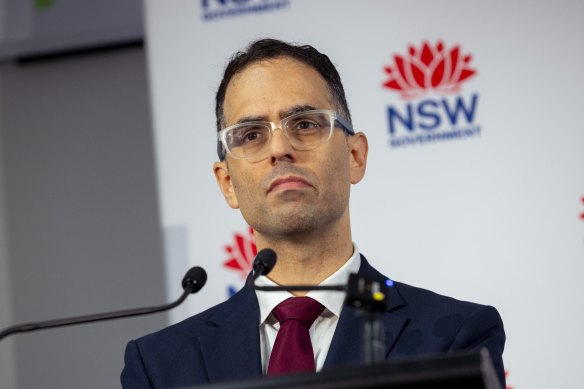This was published 6 months ago
Editorial
Sydney’s housing misery underwrites Labor’s second budget
For months now we have been told to brace for the worst in Labor’s second budget since returning to power. But the reality delivered by Treasurer Daniel Mookhey on Tuesday substantially differed from the doom and gloom rhetoric.

NSW Treasurer Daniel Mookhey speaks at the state budget press conference.Credit: Dominic Lorrimer
The great irony of this unashamedly Labor budget is that the property boom, which has turned Sydney into a misery for so many prospective home buyers and renters, is pouring vast amounts of cash into government coffers. Indeed, the bulk of the $10.7 billion in additional revenue expected over the next four years comes courtesy of a higher haul in transfer duty and land tax worth a combined $7.9 billion, mostly from the sale of properties over $1 million. Mookhey and NSW Premier Chris Minns are cursed by Sydney’s absurd property market yet blessed by it.
While the picture is rosier than the past rhetoric, it is still important to understand the backdrop against which this budget is being delivered.
NSW claims it has $11.9 billion less to play with over the next four years due to an unfair GST carve-up by the Commonwealth Grants Commission. To make matters worse, interest repayments remain high, and the government has also taken a hit to the bottom line due to the need to revalue assets and estimate the replacement cost at a time of high inflation.
Is it unusual for a government to face challenges as they put together a budget? Of course not. Every administration of all political persuasions makes the same argument. But some of the challenges confronting NSW – particularly servicing our COVID-induced debt burden and the likelihood of declining GST revenues – are real.
The $11.9 billion GST “rip-off” repeatedly cited by Mookhey is disputed because it is based largely on forecasts rather than “real” money. Mookhey’s problem here must be frustrating because putting together a state budget requires four-year projections for revenue. However, the Commonwealth only offers projections on GST distributions on a 12-monthly basis. The state has to forecast something, so has used the hopeful but probably fallacious assumption that the Commonwealth Grants Commission would split GST money in a favourable way to NSW.
NSW has therefore calculated what it was expecting to get versus what it is now likely to get based on this year’s lower distribution. Are the assumptions generous to NSW? Probably. But either way, the reality is NSW will receive less in GST than it deserves, or the government had expected.
That said, by the treasurer’s own concession the GST blow is not as severe as it could have been thanks to the property boom, a slowing of interest repayment growth, and a reorganisation of state investment funds which is expected to deliver a larger return of about $1.6 billion which can then be spent on basic government services.
The best policy in the budget is a long-overdue $5.1 billion commitment to boost social housing supply in NSW. The project calls for 6200 new homes and the knocking down and rebuilding of 2200 existing homes in disrepair. Some 33,500 homes will also get a spruce up.
Mookhey calls it “the biggest single investment in social housing any NSW government has made in the federation’s history”. Much of the credit for this result goes to Housing Minister Rose Jackson, who has shown real dynamism in this widely unloved portfolio. Social housing is rarely a vote winner, so Labor deserves credit for making it the centrepiece of its second budget.
A vow to quarantine 50 per cent of the new build for women domestic violence survivors is also welcome. That means 3100 new homes for women stuck on waiting lists. It is smart policy, and smart politics at a time when the public’s attention on the scourge of gendered violence is so strong.
In his budget papers, Mookhey says the broader circumstances behind the budget required a “calm and measured response”. It also would have been tempting to throw some cost of living pork at voters, but the treasurer thankfully avoided rolling out that barrel. The absence of an election until 2027 helps. But this is a cunning budget that offends no one and leaves very few losers.
Mookhey and Finance Minister Courtney Houssos are a good double act, and steady hands on the state’s finances. But Mookhey is a sharp policy mind who must surely be growing tired of delivering steady-as-she-goes budgets.
In his speech, the treasurer framed this budget as an essential repair job which will set the state up well for the future. “This budget does not seem to transform NSW immediately. I am not claiming that. But I do say that it builds the foundations of a better NSW.”
That may be so, but it still remains unclear what Labor’s bigger ambition for NSW looks like.
Get a weekly wrap of views that will challenge, champion and inform your own. Sign up for our Opinion newsletter.